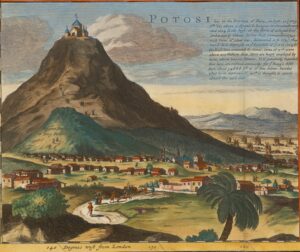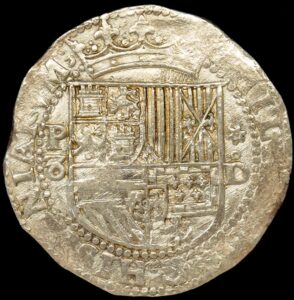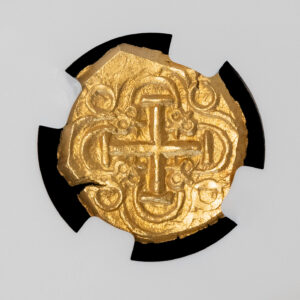From the 16th through the 18th century, Spain was the world’s leading producer of gold and silver. This began with the discovery of rich silver ore deposits in Mexico in the 1530’s followed by the discovery in 1545 of the Motherlode in Potosi, Bolivia known as El Cerro Rico (Spanish for “The Rich Mountain”). This mountain was the richest source of silver in the history of mankind. It is estimated that 80% of the world’s silver supply came out of this mine alone.
through the 18th century, Spain was the world’s leading producer of gold and silver. This began with the discovery of rich silver ore deposits in Mexico in the 1530’s followed by the discovery in 1545 of the Motherlode in Potosi, Bolivia known as El Cerro Rico (Spanish for “The Rich Mountain”). This mountain was the richest source of silver in the history of mankind. It is estimated that 80% of the world’s silver supply came out of this mine alone.
Rich deposits of gold and silver were also found in Peru, Columbia, and other Spanish colonies. Once extracted, melted and refined, the gold and silver were converted into coins and bars and then shipped back to Spain.
As a result of this seemingly endless source of wealth, the Spanish empire was able to expand and become the dominant superpower across the globe. However, history shows that Spain’s reign would be relatively short lived as a series of events would lead to her downfall. This began with the loss of the Spanish Armada to the British navy in 1588, when Catholic King Philip II tried to invade England and overthrow the Protestant Queen Elizabeth I. This was followed by a string of lost wars, political upheaval, plagues, weak kings and the frequent loss of Spain’s vital source of revenue – its treasure galleons.
Storms, naval battles, and pirates all took their toll on Spanish merchant vessels and galleons carrying the king’s gold and silver. From about 1650 through 1730 pirates, buccaneers, and privateers, as well as opposing navies roamed the Spanish Main hunting for Spanish prey. Famous figures included Edward Teach, better known as “Blackbeard”, Sir Francis Drake, known by the Spanish as “El Draque” or “The Dragon”, Calico Jack, Henry Morgan and Amaro Pargo to name a few.
These and hundreds of others roamed the Caribbean, Gulf of Mexico, and Atlantic trade routes where they attacked countless ships and made off with untold riches and treasure, including tons of gold and silver Spanish cobs. For more information on famous Spanish pirates visit: http://eskify.com/10-greatest-spanish-pirates-from-history/
What is a Cob?
 Some experts believe that the word “cob” comes from the Spanish phrase “cabo de barra,” which means “end of the bar” – referring to the piece of silver clipped off the end of a crudely poured silver or gold bar or strap.
Some experts believe that the word “cob” comes from the Spanish phrase “cabo de barra,” which means “end of the bar” – referring to the piece of silver clipped off the end of a crudely poured silver or gold bar or strap.
Silver cobs were first produced in Mexico in 1536 with the opening of the Mexico City Mint and continued to be struck at the Potosi Mint through 1773. Beginning with the reign of King Philip II (1556-1598), the design typically incorporated the Spanish coat of arms or shield on the obverse side (except on ½ reales, transitional pieces, or coins minted in certain mints), and a cross with castles and lions representing the union of Church and State on the reverse.
Each mint had an assayer “ensayador,” who oversaw the minting of the coins for the king. The process of making cobs involved cutting a piece off the bar or strap, weighing it, and then clipping or chiseling small pieces off until it reached the desired weight. As cobs were irregularly cut planchets and the methods of manufacturing coins during the period was not a perfect art, cobs are often found to be underweight or overweight. The proper weights for silver reales and gold escudos minted from 1568 to 1729 are as follows:
Silver Gold
8 reales = 27.47 grams 8 escudos = 27.06 grams
4 reales = 13.73 grams 4 escudos = 13.53 grams
2 reales = 6.87 grams 2 escudos = 6.77 grams
1 reale = 3.43 grams 1 escudo = 3.34 grams
½ reale = 1.72 grams No equivalent
¼ reale = .86 gram No equivalent
Some cobs are often thick and uneven, which required far more hammer striking force for the die’s image to fully impart on the planchet. This is why some cobs display cracks or only a small portion of the die’s design. This also accounts for a large quantity of double-struck cobs.
 Cobs recovered from shipwrecks, such as those recovered from the 1715 Fleet that sunk off of Florida are very popular, although finding silver pieces with clear details can be tough, as saltwater exposure over centuries causes severe corrosion. Regardless of condition, cobs that come from famous shipwrecks will always have a strong collector base.
Cobs recovered from shipwrecks, such as those recovered from the 1715 Fleet that sunk off of Florida are very popular, although finding silver pieces with clear details can be tough, as saltwater exposure over centuries causes severe corrosion. Regardless of condition, cobs that come from famous shipwrecks will always have a strong collector base.
Non-shipwreck cobs are also highly sought after, especially examples in higher grades of preservation. Based on current population reports from NGC and PCGS, very few silver cobs have been graded higher than Extra Fine (XF), which indicates that precious few have survived over the centuries without being melted down, damaged, or turned into jewelry.
Unique Characteristics of Cobs
The varieties and unique characteristics of cobs are limitless. Varieties include the coin’s shape, mintmarks, legends, assayer’s initials, denomination, design varieties for different kings or mints, variations in the designs of the castles and lions, and so on.
Some cobs include partial or full dates, while others do not show any. Some rare cobs called “Corazóns” or hearts were specially minted in the shape of a heart and nice specimens often cost thousands of dollars.
 According to Sewall Menzel, author of “Cobs, Pieces of Eight and Treasure Coins“, cob dies didn’t last long. “During the period of the year, dozens would be expended, requiring the diesinker to replenish them on a weekly, if not virtually daily basis. Over time, even the die punches would wear out, causing die-breaks or partial letters and symbols in the design. Sometimes, when the die punches for a given denomination were worn down and became unusable, the diesinker would select letters and symbols from other denomination sets and substitute them. For this reason, one sometimes finds symbols and letters for 2-reales coins being used on 1-reale dies, 4-reales die letters and symbols for royal arms substituted in place of 2-reales die-punched forms, and 8-reales dies sometimes used in the striking of 4-reales coin flans. Along the same line Z and S are frequently found in place of the numeral 2 as a denomination or as part of the date.”
According to Sewall Menzel, author of “Cobs, Pieces of Eight and Treasure Coins“, cob dies didn’t last long. “During the period of the year, dozens would be expended, requiring the diesinker to replenish them on a weekly, if not virtually daily basis. Over time, even the die punches would wear out, causing die-breaks or partial letters and symbols in the design. Sometimes, when the die punches for a given denomination were worn down and became unusable, the diesinker would select letters and symbols from other denomination sets and substitute them. For this reason, one sometimes finds symbols and letters for 2-reales coins being used on 1-reale dies, 4-reales die letters and symbols for royal arms substituted in place of 2-reales die-punched forms, and 8-reales dies sometimes used in the striking of 4-reales coin flans. Along the same line Z and S are frequently found in place of the numeral 2 as a denomination or as part of the date.”
For some cob collectors, the most-prized specimens are those that display the most complete details of what the original die represented and those in the highest state of preservation. Finding a silver cob in AU or Mint State grades that is center struck on both sides and displays most of the legends and design elements is like finding a needle in a haystack.
Not only are there numerous variations and differences in the design of the shields, crowns, castles, lions, and legends but there are also some that display obvious die errors. For example, on the reverse side of a cob, you typically see a castle in the upper left quadrant of the cross and lower right, with the lions positioned in the upper right and lower left. Some examples have the castles and lions reversed or transposed.
Whether a cob was recovered from a famous shipwreck like the 1715 Fleet, or is a specimen that somehow survived through the centuries unscathed, they are great pieces of numismatic history to collect and cherish.
When it comes to the lore of lost treasure, naval battles, conquest, and the exploits of pirates, nothing makes a collector’s imagination soar like holding a centuries-old Piece of Eight or gold doubloon in your hand!
For more information on cobs and a vast array of resources, visit: www.Macuquina.com
Written by Sean Scott

Leave a Reply